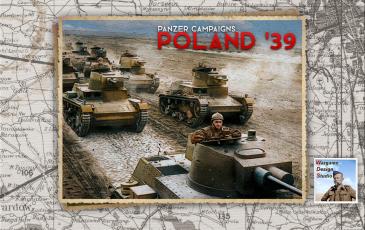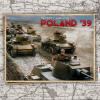0901_02a_Border - Allied AI - PzC 31 Poland '39

b59375da7db50f7a9280.jpg) 0 - 0 - 0
0 - 0 - 0
4f09d1569063283d124d.jpg)
| Rating: | 0 (0) |
| Games Played: | 0 |
| SM: | 4 |
| Turns: | 28 |
| Type: | Stock |
| First Side: | Axis (Poland-39) |
| Second Side: | Allies (Poland-39) |
Date: September 1st, 1939 - Size: Large - Location: Western Poland
Intended for play as Axis Human vs Allied AI or Head to Head
Scenario Briefing: On the eve of war, the Polish army seemed hopelessly outnumbered. Only 700,000 had been mustered into the Polish ranks while Germany had mobilized an army numbering more than 2,000,000. If Poland was to have any chance at stopping a German attack, it needed to continue the mobilization until every man that could be armed had been called up. This presented the Polish military leadership with a dilemma. It was well understood that Poland's smaller army could not stand against the might of the Wehrmacht if it was spread thinly along the entire border, but if it concentrated behind naturally defensible barriers in the interior of the country it would cede important population centers and jeopardize further mobilization efforts. There was therefore no choice but to defend the border, if only temporarily.
The Polish land forces would be divided into six principal field armies, each with two to five infantry divisions, a cavalry brigade or two, and some limited supporting armor and artillery. Army Modlin defended the Mlawa and Modlin fortifications and the Vistula bridges north of Warsaw, Army Pomorze deployed awkwardly astride the Vistula in defence of the Polish Corrider, Army Poznan was positioned in a precarious forward position in the western reaches of the country, Army Lodz defended its namesake city and the southwestern approaches to Warsaw, and Army Krakow was principally charged with defending the valuable industrial centers in Silesia. Army Prusy, only partly mobilized, would act as a strategic reserve.
Against these forces, the Germans deployed five much larger field armies, each with four to eight infantry divisions, up to four armored divisions, and ample artillery and engineering assets. 3rd Army was to advance south from East Prussia against Army Modlin, applying pressure on Warsaw and Modlin from the north. 4th Army would attack Army Pomorze, cross the Polish corridor, and seize important bridges over the Vistula. 8th Army, the smallest of the German armies deployed against Poland, would act as a flank guard for the powerful 10th Army as it drove on Warsaw from the southwest. 14th Army was to outflank the Katowice fortifications with an attack out of Slovakia.
The attack commenced at dawn. Though the Poles would fight with exemplary courage and tenacity, it would soon become evident that such a thinly-spread force could not hope to stand against the sheer weight of German numbers.
Recommended Rules: (Default)
Alternative Assault Resolution, Artillery Set Up, Recon Spotting, Virtual Supply Trucks, Optional Surrender, Low Visibility Air Effects, Quality Fatigue Modifier, Counter Battery Fire, Night Fatigue, Programmed Weather.
Additionally, Delayed Disruption Reporting will provide a more challenging experience for the attacking player.
1. This short version of the scenario lasts from September 1st-3rd and focuses on the fighting at the border.
2. Many distant, high-value objective hexes located behind the Vistula, Narew, Warta, and Widawka rivers and in various towns and cities are not needed for a German victory and are likely inaccessible given the short duration of the scenario. They are meant to reward the German player should he achieve some improbable breakthrough. It is not possible for the German player to capture every objective and he does not need to in order to win.
3. Some low-value objectives near the border expire at the end of the first day. These may be very difficult to capture before they expire and are not required for a German victory. Their purpose is to penalize the Polish player somewhat should he choose to abandon the border immediately.
4. This scenario uses conditional reinforcements. The arrival of some Polish reinforcements is tied to control of certain objective hexes.
Intended for play as Axis Human vs Allied AI or Head to Head
Scenario Briefing: On the eve of war, the Polish army seemed hopelessly outnumbered. Only 700,000 had been mustered into the Polish ranks while Germany had mobilized an army numbering more than 2,000,000. If Poland was to have any chance at stopping a German attack, it needed to continue the mobilization until every man that could be armed had been called up. This presented the Polish military leadership with a dilemma. It was well understood that Poland's smaller army could not stand against the might of the Wehrmacht if it was spread thinly along the entire border, but if it concentrated behind naturally defensible barriers in the interior of the country it would cede important population centers and jeopardize further mobilization efforts. There was therefore no choice but to defend the border, if only temporarily.
The Polish land forces would be divided into six principal field armies, each with two to five infantry divisions, a cavalry brigade or two, and some limited supporting armor and artillery. Army Modlin defended the Mlawa and Modlin fortifications and the Vistula bridges north of Warsaw, Army Pomorze deployed awkwardly astride the Vistula in defence of the Polish Corrider, Army Poznan was positioned in a precarious forward position in the western reaches of the country, Army Lodz defended its namesake city and the southwestern approaches to Warsaw, and Army Krakow was principally charged with defending the valuable industrial centers in Silesia. Army Prusy, only partly mobilized, would act as a strategic reserve.
Against these forces, the Germans deployed five much larger field armies, each with four to eight infantry divisions, up to four armored divisions, and ample artillery and engineering assets. 3rd Army was to advance south from East Prussia against Army Modlin, applying pressure on Warsaw and Modlin from the north. 4th Army would attack Army Pomorze, cross the Polish corridor, and seize important bridges over the Vistula. 8th Army, the smallest of the German armies deployed against Poland, would act as a flank guard for the powerful 10th Army as it drove on Warsaw from the southwest. 14th Army was to outflank the Katowice fortifications with an attack out of Slovakia.
The attack commenced at dawn. Though the Poles would fight with exemplary courage and tenacity, it would soon become evident that such a thinly-spread force could not hope to stand against the sheer weight of German numbers.
Recommended Rules: (Default)
Alternative Assault Resolution, Artillery Set Up, Recon Spotting, Virtual Supply Trucks, Optional Surrender, Low Visibility Air Effects, Quality Fatigue Modifier, Counter Battery Fire, Night Fatigue, Programmed Weather.
Additionally, Delayed Disruption Reporting will provide a more challenging experience for the attacking player.
1. This short version of the scenario lasts from September 1st-3rd and focuses on the fighting at the border.
2. Many distant, high-value objective hexes located behind the Vistula, Narew, Warta, and Widawka rivers and in various towns and cities are not needed for a German victory and are likely inaccessible given the short duration of the scenario. They are meant to reward the German player should he achieve some improbable breakthrough. It is not possible for the German player to capture every objective and he does not need to in order to win.
3. Some low-value objectives near the border expire at the end of the first day. These may be very difficult to capture before they expire and are not required for a German victory. Their purpose is to penalize the Polish player somewhat should he choose to abandon the border immediately.
4. This scenario uses conditional reinforcements. The arrival of some Polish reinforcements is tied to control of certain objective hexes.





















